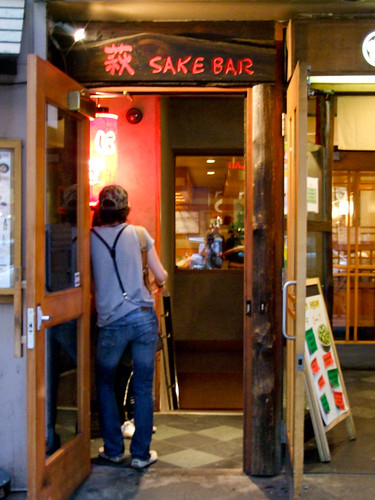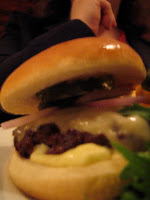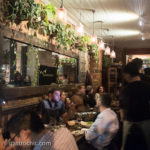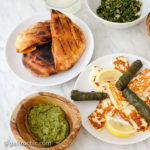Tag Archives: beer
Cinco de Mayo Recipe: Michelada ZAMAS
 Poor Mexico! Just when they were getting the drug cartels under control, along comes the swine flu. On this Cinco de Mayo, toast to their improved health – and the future health of tourism there – with a Michelada.
Poor Mexico! Just when they were getting the drug cartels under control, along comes the swine flu. On this Cinco de Mayo, toast to their improved health – and the future health of tourism there – with a Michelada.
Translating literally as “my frozen beer,” the Michelada is hard to find outside of Mexico but extremely easy to make. On a recent trip to Tulum, I tried one at Zamas, a pretty beachside resort with a great open-air restaurant. The taste reminded me not just of a Bloody Mary but more specifically JG Mellon’s Bloody Bull, made with beef bouillon. (more…)
Resto
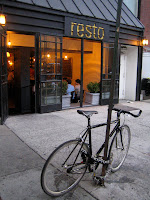 What happens when Frank Bruni leaves the building? Can a restaurant keep its standards high after a positive review, or do they just keep on gettin’ through the gettin’ through? Bruni knighted Resto a “terrific new restaurant” in mid-May. Since his rapturous descriptions of Resto’s hearty, meaty fare appeared at the beginning of a hot summer, Marie Fromage and I waited til fall-ish to sample it.
What happens when Frank Bruni leaves the building? Can a restaurant keep its standards high after a positive review, or do they just keep on gettin’ through the gettin’ through? Bruni knighted Resto a “terrific new restaurant” in mid-May. Since his rapturous descriptions of Resto’s hearty, meaty fare appeared at the beginning of a hot summer, Marie Fromage and I waited til fall-ish to sample it.
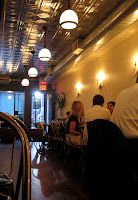 Resto sits on a quiet stretch of 29th Street, its simple, white-washed and wood-floored interior making it a bare bones but welcoming kind of place, with basic gastro pub decor that echoes the Half King’s on 23rd Street. Like the Half King, in the off hours it can be a good place for a beer and a conversation, but when it fills up, the uncarpeted space can get loud.
Resto sits on a quiet stretch of 29th Street, its simple, white-washed and wood-floored interior making it a bare bones but welcoming kind of place, with basic gastro pub decor that echoes the Half King’s on 23rd Street. Like the Half King, in the off hours it can be a good place for a beer and a conversation, but when it fills up, the uncarpeted space can get loud.
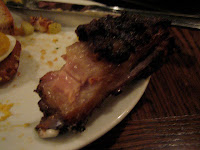 Of course, one of the main draws here is the lamb ribs. These were the highlight of Bruni’s review, and they were as much of a cholesterol-laden thrill as promised. Charred on the outside and tender within, rubbed in a Indian spice blend, they were just as meaty and fatty as any rib eater could handle. Served with a yogurt sauce alongside, they tasted like donner kebab elevated to gourmet status.
Of course, one of the main draws here is the lamb ribs. These were the highlight of Bruni’s review, and they were as much of a cholesterol-laden thrill as promised. Charred on the outside and tender within, rubbed in a Indian spice blend, they were just as meaty and fatty as any rib eater could handle. Served with a yogurt sauce alongside, they tasted like donner kebab elevated to gourmet status.
The Middle Eastern and Asian influences throughout this Belgian restaurant may seem odd, but they’re an accurate reflection of chef Ryan Skeen’s 5 Ninth training and of what European food is now, not a nostalgic view of what it was a couple decades ago. Though you may think of moules frites when you think of Belgium, shawarma is insanely popular there now.
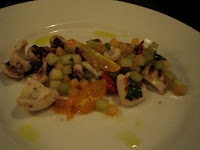 Cuttlefish, which is closely related to squid, arrived in a salad special and provided a nice, lightly acidic counterpart to the meat dishes. Drizzled on the bottom of the plate was a romanesco sauce the Spanish joints in town have taught us to crave. We only wished there was more of it.
Cuttlefish, which is closely related to squid, arrived in a salad special and provided a nice, lightly acidic counterpart to the meat dishes. Drizzled on the bottom of the plate was a romanesco sauce the Spanish joints in town have taught us to crave. We only wished there was more of it.
 Whatever health benefits we gained with the light cuttlefish salad were immediately undercut by the deep fried crispy pork toast lurking under the deviled eggs. These were too heavy even by our fat-seeking standards and overwhelmed the relatively delicate taste of the eggs.
Whatever health benefits we gained with the light cuttlefish salad were immediately undercut by the deep fried crispy pork toast lurking under the deviled eggs. These were too heavy even by our fat-seeking standards and overwhelmed the relatively delicate taste of the eggs.
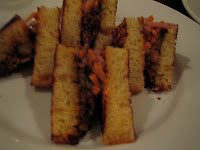 On the other hand, some items were not as indulgently fatty as previously reported. The staff kindly brought us the “tête de cochon” sandwich Bruni chronicled, though it is no longer on the menu. These little pork jowl sandwiches were also kind of “meh” for something dubbed “tête de cochon.” The ratio of meat to bread should be higher for true decadence. Shredded carrots seemed an odd touch, but according to Marie Fromage, carrots are used in almost everything German that requires vegetables.
On the other hand, some items were not as indulgently fatty as previously reported. The staff kindly brought us the “tête de cochon” sandwich Bruni chronicled, though it is no longer on the menu. These little pork jowl sandwiches were also kind of “meh” for something dubbed “tête de cochon.” The ratio of meat to bread should be higher for true decadence. Shredded carrots seemed an odd touch, but according to Marie Fromage, carrots are used in almost everything German that requires vegetables.
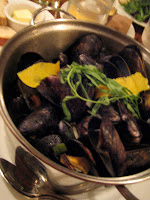 Whatever the shortcomings of the appetizers, these nibbly bar snacks were better than the entrees, which disappointed after all the Bruni brouhaha. Moules frites with witte ale were nothing to write home about, and the burger was just too small. The burger circumference must be the same as or bigger than the bun; it’s a cardinal rule of burgers. Try serving anything smaller to a child and you’ll get a wail of discontent, which was what we felt. But the fries that came alongside were delicious, especially when dipped in the mayo with onion sauce.
Whatever the shortcomings of the appetizers, these nibbly bar snacks were better than the entrees, which disappointed after all the Bruni brouhaha. Moules frites with witte ale were nothing to write home about, and the burger was just too small. The burger circumference must be the same as or bigger than the bun; it’s a cardinal rule of burgers. Try serving anything smaller to a child and you’ll get a wail of discontent, which was what we felt. But the fries that came alongside were delicious, especially when dipped in the mayo with onion sauce.
This is not to say that Resto is not worth visiting. On a cool autumn night, there would be few things better than a pint of one of Resto’s many excellent and rare Belgian ales on tap, a platter of lamb ribs and a side of fries devoured at the underused bar. Just don’t come expecting nirvana, because apparently a good Bruni review can be a hard act to follow – especially for the restaurant.
Resto
111 E. 29th Street, between Park Avenue South and Lexington
New York, New York
212-947-3636
Hill Country
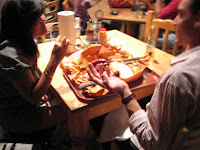 Fette Sau is a hard act to follow.
Fette Sau is a hard act to follow.
This became apparent as soon as we walked into Hill Country. Where was the smell of barbecue? In Williamsburg, the scent of roasting meat bewitches you a block away, here there was barely a whiff of it, even when the counter staff opened the cantilevered storage units that contain piles of brisket, beef ribs, and fatty pork.
 Manhattan might mean “island of many hills,” but this ain’t the boonies anymore. If Texas-inspired Hill Country exuded that barbecue scent, the neighbors would be hoppin’ mad. (It’s tough not to lapse into Texas talk as soon as you get here, what with the honky tonk music on the stereo.) On the other hand, Hill Country is conveniently located just blocks away from several subway lines, and this, as my fellow diner the Cheese Guy pointed out, is its biggest advantage. The cavernous hall, lined on one side with piles of firewood, chock full of wooden tables, and punctuated by BBQ and beer stations, easily fills with Manhattan diners, many of them guys in ties. This doesn’t even include the equally cavernous downstairs space, which has several long tables for large parties and live music several nights a week. But dang if it ain’t hard to hear in Hill Country: the acoustics are terrible.
Manhattan might mean “island of many hills,” but this ain’t the boonies anymore. If Texas-inspired Hill Country exuded that barbecue scent, the neighbors would be hoppin’ mad. (It’s tough not to lapse into Texas talk as soon as you get here, what with the honky tonk music on the stereo.) On the other hand, Hill Country is conveniently located just blocks away from several subway lines, and this, as my fellow diner the Cheese Guy pointed out, is its biggest advantage. The cavernous hall, lined on one side with piles of firewood, chock full of wooden tables, and punctuated by BBQ and beer stations, easily fills with Manhattan diners, many of them guys in ties. This doesn’t even include the equally cavernous downstairs space, which has several long tables for large parties and live music several nights a week. But dang if it ain’t hard to hear in Hill Country: the acoustics are terrible.
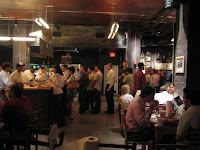 We queued up for ‘cue, which is sold by the pound. In a Katz’s-like system, you get a ticket at the outset and get your own food. This is true to Texas style, so if you prefer table service, chances are you’d be better off in a fancy-pants New York place.
We queued up for ‘cue, which is sold by the pound. In a Katz’s-like system, you get a ticket at the outset and get your own food. This is true to Texas style, so if you prefer table service, chances are you’d be better off in a fancy-pants New York place.
The biggest difference between Hill Country and Fette Sau is the smoker, or lack of a huge, hardworking one like Fette Sau’s Southern Queen. Hill Country’s brisket is juicier than Fette Sau’s, probably because it’s been cooked for a shorter time. But as any barbecue aficionado can tell you, this means it loses something in the flavor department. The 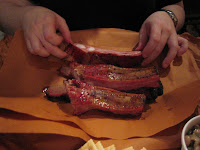 rub on the outside is good, but it doesn’t penetrate far into the beef. The same goes for nicely peppery rub on the pork ribs. And if you ever wonder whether the current Berkshire pork obsession is just spin, contrast and compare the two meats and you’ll taste the difference. Because of the shorter cooking time, Hill Country’s non-Berkshire pork ribs were still pink inside and chewy, not falling off the bone.
rub on the outside is good, but it doesn’t penetrate far into the beef. The same goes for nicely peppery rub on the pork ribs. And if you ever wonder whether the current Berkshire pork obsession is just spin, contrast and compare the two meats and you’ll taste the difference. Because of the shorter cooking time, Hill Country’s non-Berkshire pork ribs were still pink inside and chewy, not falling off the bone.
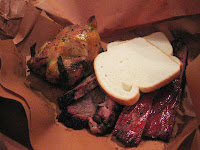 The beer can game hen proved to be a worthwhile experiment. Deep fried with an open beer can inside, it tasted nicely herbal and moist, with crispy skin. It had flavors I didn’t realize hen or canned beer could have. How they managed to wedge a whole can o’ beer in this lil’ critter I’ll never know.
The beer can game hen proved to be a worthwhile experiment. Deep fried with an open beer can inside, it tasted nicely herbal and moist, with crispy skin. It had flavors I didn’t realize hen or canned beer could have. How they managed to wedge a whole can o’ beer in this lil’ critter I’ll never know.
 Unlike Fette Sau, Hill Country is not hostile to vegetarians. There are a heap of sides, many of them meat free. Sharp, slightly oily Longhorn cheddar decked the pasta in the excellent mac-n-cheese, and the corn pudding is perfectly salty-sweet. Black eyed pea salad was ho-hum, and chipotle deviled eggs sounded much more exciting than they were, but they’re a nice apertif to the barbecue if you get hungry waiting in line.
Unlike Fette Sau, Hill Country is not hostile to vegetarians. There are a heap of sides, many of them meat free. Sharp, slightly oily Longhorn cheddar decked the pasta in the excellent mac-n-cheese, and the corn pudding is perfectly salty-sweet. Black eyed pea salad was ho-hum, and chipotle deviled eggs sounded much more exciting than they were, but they’re a nice apertif to the barbecue if you get hungry waiting in line.
 Normally I wouldn’t review a place this early on, but I had an opportunity to go and a camera, so please consider this an early report. Over the course of the evening, however, it became apparent that a lot of thought has already gone into Hill Country. By “thought,” I mean “focus group input.” Like the latest designer fragrance, nothing in the formula offends, but nothing sticks out at you, either. The faux-fluorescent lighting and kitschy props nailed to the walls reminded me of TGI Fridays or Chili’s, though thankfully none of the servers are wearing “flare.” Hill Country has only been open for a matter of weeks, but their in-house barbecue sauce is already for sale at the gift counter by the door, though it’s a pretty average sauce. Setting up a gift counter before you have a devoted following seems like creating your own celebrity fan club before you’re even famous.
Normally I wouldn’t review a place this early on, but I had an opportunity to go and a camera, so please consider this an early report. Over the course of the evening, however, it became apparent that a lot of thought has already gone into Hill Country. By “thought,” I mean “focus group input.” Like the latest designer fragrance, nothing in the formula offends, but nothing sticks out at you, either. The faux-fluorescent lighting and kitschy props nailed to the walls reminded me of TGI Fridays or Chili’s, though thankfully none of the servers are wearing “flare.” Hill Country has only been open for a matter of weeks, but their in-house barbecue sauce is already for sale at the gift counter by the door, though it’s a pretty average sauce. Setting up a gift counter before you have a devoted following seems like creating your own celebrity fan club before you’re even famous.
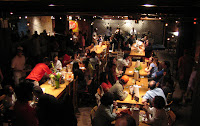 Nevertheless, since this is the kind of free-range place where no one kicks you out, we meandered downstairs to listen to live blues. The luckiest moment of the night came when one of the sous chefs literally tossed Chef Mary and me a bourbon pecan pie at the bar. It was hands down the most delicious pecan pie we’ve ever eaten (sorry, Mom), loaded with fresh nuts and laced with bourbon and molasses.
Nevertheless, since this is the kind of free-range place where no one kicks you out, we meandered downstairs to listen to live blues. The luckiest moment of the night came when one of the sous chefs literally tossed Chef Mary and me a bourbon pecan pie at the bar. It was hands down the most delicious pecan pie we’ve ever eaten (sorry, Mom), loaded with fresh nuts and laced with bourbon and molasses.
The bourbon pecan pie, the sugared bar nuts, the bands, the friendly counter staff, the space for huge parties, and the location are all good reasons to return to Hill Country – and the Kruez sausage is supposed to be a tasty Texas specialty as well, though we didn’t get a chance to try it. But if I have a hankering for pork ribs again, I’ll be danged if I’m not on the first train out to Williamsburg.
Hill Country
30 West 26th Street, between Fifth and Sixth Avenues
New York, New York
212-255-4544
Blue Crab Mondays at the Hideaway
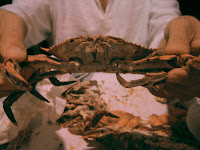 If you can’t find a favorite hometown food in New York City, do you a) return home as often as possible to eat it, b) learn to cook, or c) open a restaurant and start serving that hometown food to all New Yorkers?
If you can’t find a favorite hometown food in New York City, do you a) return home as often as possible to eat it, b) learn to cook, or c) open a restaurant and start serving that hometown food to all New Yorkers?
Fortunately for New York, hungry entrepreneurs have been answering “C” for centuries now. In the case of Justin Palmer of the Hideaway, first came the bar and restaurant, then came the bluefin crabs. Unable to find a place dedicated to serving hardshell crabs from Maryland or his native Virginia, he contacted his longtime crab supplier and started flying bushels of bluefins up every weekend. Now the Hideaway, a bar and restaurant started by four friends who wanted their own “clubhouse” in Tribeca, has become a mecca for transplanted crab lovers from up and down the Eastern seaboard.
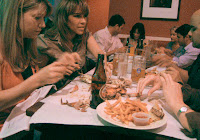 If you don’t know from crabs, you may think a restaurant like City Crab is enough. It’s not. A real crab shack doesn’t have newfangled things like sushi on the menu, nor should it dabble in crabs from here, there, and everywhere. As for places that specialize in Cajun food, do what you will with crawfish, but the words “crab” and “boil” should never appear next to each other. In a real crab shack, the tables are covered in paper, the paper’s covered in steamed bluefin crabs, the crabs are covered in Old Bay, and the diners are covered in crab. It’s seafood gluttony at its finest.
If you don’t know from crabs, you may think a restaurant like City Crab is enough. It’s not. A real crab shack doesn’t have newfangled things like sushi on the menu, nor should it dabble in crabs from here, there, and everywhere. As for places that specialize in Cajun food, do what you will with crawfish, but the words “crab” and “boil” should never appear next to each other. In a real crab shack, the tables are covered in paper, the paper’s covered in steamed bluefin crabs, the crabs are covered in Old Bay, and the diners are covered in crab. It’s seafood gluttony at its finest.
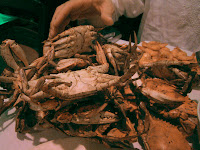 Do not be afraid if you don’t know how to tackle this crustacean. The Hideaway makes it easy, providing instructions for how to eat a crab on their menu, and chances are the diners at the next table would be more than happy to help out with tips. I would say you burn nearly as many calories opening them as you do consuming them, but we were served at least 15 crabs on our order of a dozen. The generosity didn’t stop there: the crabs were caked in Old Bay and steamed just right, even though the chef was working with a more difficult pot-on-the-stove system rather than the steamers dedicated to crabs that you see further south.
Do not be afraid if you don’t know how to tackle this crustacean. The Hideaway makes it easy, providing instructions for how to eat a crab on their menu, and chances are the diners at the next table would be more than happy to help out with tips. I would say you burn nearly as many calories opening them as you do consuming them, but we were served at least 15 crabs on our order of a dozen. The generosity didn’t stop there: the crabs were caked in Old Bay and steamed just right, even though the chef was working with a more difficult pot-on-the-stove system rather than the steamers dedicated to crabs that you see further south.
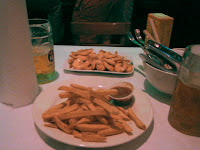 We also tried the shrimp and the fries, but both of these paled next to the succulent crabs. Non-seafood fans can opt for the hefty burger, which has been a draw at the Hideaway even before the crabs came.
We also tried the shrimp and the fries, but both of these paled next to the succulent crabs. Non-seafood fans can opt for the hefty burger, which has been a draw at the Hideaway even before the crabs came.
 Though Blue Crab Mondays have brought the Hideaway into the limelight, the place still retains its clubhouse feel. Led Zeppelin plays on the stereo, major league baseball plays on the TV, and the walls are decked with slick photographs of a young Mick Jagger, Jimi Hendrix, and Carolina basketball stars. (Several of the owners attended Duke.) When all the crabs were gone and the waitress had swept up the shell debris from under the tables, the chef, staff, and owners got together and did a shot behind the bar. Now this is the kind of place anybody could call home.
Though Blue Crab Mondays have brought the Hideaway into the limelight, the place still retains its clubhouse feel. Led Zeppelin plays on the stereo, major league baseball plays on the TV, and the walls are decked with slick photographs of a young Mick Jagger, Jimi Hendrix, and Carolina basketball stars. (Several of the owners attended Duke.) When all the crabs were gone and the waitress had swept up the shell debris from under the tables, the chef, staff, and owners got together and did a shot behind the bar. Now this is the kind of place anybody could call home.
The Hideaway
185 Duane Street, between Hudson and Greenwich Streets
New York, New York
212-334-5775
How To Eat a Crab:
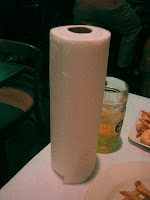 1) Make sure you have the necessary accoutrements: a mallet, paper towels, and beer.
1) Make sure you have the necessary accoutrements: a mallet, paper towels, and beer.
2) Remove the claws and legs.
3) Pull off the pointy underside piece, the “apron.”
4) Slide your thumb in the opening between the crab body and top shell. 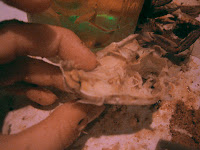 Pull off the shell.
Pull off the shell.
5) Tear off the spongy “lungs,” scoop out the “mustard” (the gunk in the cavity), and discard all.
6) Crack the crab body in half with your hands.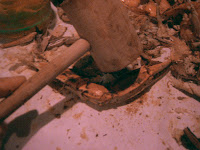
7) Pry away any of the overlying thin shell and dig into the body to extract the crab meat, then fan each half apart to get at the inner cavities.
8) Use the mallet on the claws only, tapping hard enough on 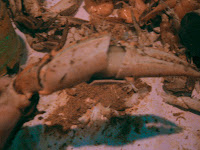 the upper part of the claw to break it but not so hard as to pulverize the meat underneath.
the upper part of the claw to break it but not so hard as to pulverize the meat underneath.
9) Save the fiddly legs for the end of the crab feast and deal with them only if you are still hungry.
Fette Sau
 Perhaps no other advertising campaign has done a greater disservice to its product than “Pork: The Other White Meat.” Borne out of the fat-phobic late ’80s, the National Pork Board’s campaign reduced the entire animal to the pork chop. If the complex, meaty, by turns fatty and lean pig could talk, she would no doubt tell you: I am so not a chicken.
Perhaps no other advertising campaign has done a greater disservice to its product than “Pork: The Other White Meat.” Borne out of the fat-phobic late ’80s, the National Pork Board’s campaign reduced the entire animal to the pork chop. If the complex, meaty, by turns fatty and lean pig could talk, she would no doubt tell you: I am so not a chicken.
Twenty years later, our obsession with barbecue and pork’s ability to take on and emphasize spicy, smoky flavors may seem new, but it has long been part of the basic vocabulary in Chinese, Korean, Italian, German, and yes, Southern cuisine. Consider this: would David Chang of Momofuku be David Chang without his silent partner, the Berkshire pig?
 It requires a certain mania for the fatty beast to see a barbecue joint in an auto body shop, bring in a crypt-sized Southern Queen smoker, make all the right connections with Berkshire pork suppliers, and open your doors for business. But that’s just what owners Kim and Joe Carroll of Fette Sau have done.
It requires a certain mania for the fatty beast to see a barbecue joint in an auto body shop, bring in a crypt-sized Southern Queen smoker, make all the right connections with Berkshire pork suppliers, and open your doors for business. But that’s just what owners Kim and Joe Carroll of Fette Sau have done.
 By now you probably know what’s on the menu: pork spareribs, pork sausages, pulled pork, plus some beef brisket to give that guy a nod too. But it’s the sau that impresses. Fatty, rich pork belly is like the foie gras of pork products. The ribs are charred on the outside, meaty and tender between the bones. There’s an espresso-and-brown-sugar rub on them, but as with the pulled pork, the true deliciousness comes from the unadulterated flavor of smoke. The Southern Queen smoker – and chef Matt Lang – sure can cook.
By now you probably know what’s on the menu: pork spareribs, pork sausages, pulled pork, plus some beef brisket to give that guy a nod too. But it’s the sau that impresses. Fatty, rich pork belly is like the foie gras of pork products. The ribs are charred on the outside, meaty and tender between the bones. There’s an espresso-and-brown-sugar rub on them, but as with the pulled pork, the true deliciousness comes from the unadulterated flavor of smoke. The Southern Queen smoker – and chef Matt Lang – sure can cook.
I’m no barbecue expert, since I come from Maryland, the no-man’s-land considered the South by Yankees but disdained by Carolinians and ignored by Texans. But barbecue experts have endorsed Fette Sau’s separation of meat from sauce, which you combine yourself at the table. The sweet sauce is the traditional mix of ketchup, vinegar, maybe a bit of Worchestershire sauce, and some other secret ingredients, but it was still my favorite because of my Southern-ish sweet tooth – same goes for the sweet white rolls. Fette Sau’s spicy sauce is a much more complex, mole-like mixture that tastes of coffee, dried chilies, molasses, and unsweetened chocolate. The two would taste great mixed together.
The non-meat sides received a drubbing in previous reviews of Fette Sau, so we skipped these – except for the excellent Gus’ half sour pickles – and headed straight for the baked beans. Embedded with hunks of brisket, they tasted like the ideal incarnation of Fette Sau’s mole-like spicy sauce.
 Though the atmosphere is pretty much the polar opposite of Frederick’s Downtown, Fette Sau does have that see-and-be-seen scene, Williamsburg version, lots of outdoor seating at picnic tables, and few rules. (“No drinks outside after 11pm.”) Walking into the garage, I felt the same kind of relief a teenager experiences upon arriving at a keg party in somebody’s indestructible concrete basement. It’s the kind of place where you can let your hair down, don some Williamsburg style glasses in weird 80’s frames à la Michael Caine, and drink a gallon of beer – literally. A slew of microbrews is dispensed from pulls rigged with butchery tools into gallon-size glass jugs. If that doesn’t spell an afternoon of Brooklyn patio drinking, I don’t know what does. Just get there early because, like Pies ‘N’ Thighs, Fette Sau tends to run out of food, usually by 9:30pm on weekends.
Though the atmosphere is pretty much the polar opposite of Frederick’s Downtown, Fette Sau does have that see-and-be-seen scene, Williamsburg version, lots of outdoor seating at picnic tables, and few rules. (“No drinks outside after 11pm.”) Walking into the garage, I felt the same kind of relief a teenager experiences upon arriving at a keg party in somebody’s indestructible concrete basement. It’s the kind of place where you can let your hair down, don some Williamsburg style glasses in weird 80’s frames à la Michael Caine, and drink a gallon of beer – literally. A slew of microbrews is dispensed from pulls rigged with butchery tools into gallon-size glass jugs. If that doesn’t spell an afternoon of Brooklyn patio drinking, I don’t know what does. Just get there early because, like Pies ‘N’ Thighs, Fette Sau tends to run out of food, usually by 9:30pm on weekends.
 The extensive list of bourbon, whiskey and rye is like the bonanza of breaking into the absentee parents’ liquor cabinet: Whiskey, all you want! We particularly liked the Tuthilltown rye and the Black Maple Hill bourbon. If you’re really daring, knowledgeable bartender Dave Herman will serve you a bit of corn mash liquor that tastes like moonshine: the ceramic jug says it all.
The extensive list of bourbon, whiskey and rye is like the bonanza of breaking into the absentee parents’ liquor cabinet: Whiskey, all you want! We particularly liked the Tuthilltown rye and the Black Maple Hill bourbon. If you’re really daring, knowledgeable bartender Dave Herman will serve you a bit of corn mash liquor that tastes like moonshine: the ceramic jug says it all.
As with a keg party, days later, my clothes still smell like smoke, but this time it’s the alluring scent of barbecue. It even makes me hungry, which is no problem, because like addicted regulars at Fette Sau, I ordered more pulled pork at the end of the night – to go.
Fette Sau
354 Metropolitan Avenue at Havemyer Street
Williamsburg, Brooklyn, New York
718-963-3404
for directions go to hopstop.com
Austin, TX
 This is a special guest entry from Chef MC, who visited Austin, TX a couple weekends ago, before all the South by Southwest music festival mayhem starts tomorrow. Here she is, pictured, left. Just kidding! I don’t know who that lady is. But whoever she is, according the SXSW website, she’ll be rockin’ it out in Austin all week.
This is a special guest entry from Chef MC, who visited Austin, TX a couple weekends ago, before all the South by Southwest music festival mayhem starts tomorrow. Here she is, pictured, left. Just kidding! I don’t know who that lady is. But whoever she is, according the SXSW website, she’ll be rockin’ it out in Austin all week.
Those of you heading down there will find some fabulous margaritas, hotels, restaurants, and shopping. Oh yes, and some more margaritas.
I am back from my weekend in Austin,TX! Here are some highlights:
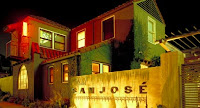 * The hotel where I stayed, the Hotel San Jose, a former motel-turned brothel-turned hip happening hot spot. I was in a “Grand Standard” room, which I referred to as “The Cell”. I would describe it as high design done on the cheap (and very well). Industrial, stark and modern, almost cold, Frette sheets and towels, very comfy bed, with a whiff of retro 1950s (which is the theme all over Austin, sometimes with Mexican mixed in). Very professional service. I would definitely stay here again.
* The hotel where I stayed, the Hotel San Jose, a former motel-turned brothel-turned hip happening hot spot. I was in a “Grand Standard” room, which I referred to as “The Cell”. I would describe it as high design done on the cheap (and very well). Industrial, stark and modern, almost cold, Frette sheets and towels, very comfy bed, with a whiff of retro 1950s (which is the theme all over Austin, sometimes with Mexican mixed in). Very professional service. I would definitely stay here again.
Food-wise, the bill of fare is varying degrees of TexMex for breakfast, lunch and dinner, with a couple of exceptions. Plus excellent coffee. My favorite spots were:
 * Uchi’s. We had a fabulous meal on Saturday night. Went on the suggestion of my friend, Chef Kevin Quinn and then heard it recommended by several others. It was basically a cool sushi place, but it had more of an Asian-fusion menu. We had the omakase tasting menu, which featured endless courses of deliciousness. It was as good as any place like it in NYC.
* Uchi’s. We had a fabulous meal on Saturday night. Went on the suggestion of my friend, Chef Kevin Quinn and then heard it recommended by several others. It was basically a cool sushi place, but it had more of an Asian-fusion menu. We had the omakase tasting menu, which featured endless courses of deliciousness. It was as good as any place like it in NYC.
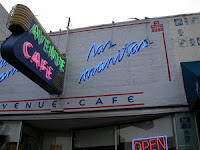 * Las Manitas. Best spot for breakfast in Austin. A fresh-fresh menu that seemed designed to provide a rescue from the margarita hangover. This was my 5th visit to the place and it always satisfies. This time around I had fresh squeezed watermelon juice and a plate of Migas Con Queso with a side of plantains. They make their own tortillas and you can watch the lady churn them out while waiting to get in to the ladies room. The menu is here.
* Las Manitas. Best spot for breakfast in Austin. A fresh-fresh menu that seemed designed to provide a rescue from the margarita hangover. This was my 5th visit to the place and it always satisfies. This time around I had fresh squeezed watermelon juice and a plate of Migas Con Queso with a side of plantains. They make their own tortillas and you can watch the lady churn them out while waiting to get in to the ladies room. The menu is here.
 * Guero’s Taco Bar. The TexMex here is fine, not amazing. Great people watching and hopping scene. Loved the margaritas. We came here for a long lunch break from shopping the funky boutiques on South Congress. Needed to head back to my hotel after lunch to take a nap. Did I mention the great margaritas? We had tortilla chips with assorted hot sauces for dipping, Queso (basically a big bowl of molten cheese with hot sauce mixed in), and I had a quesadilla platter with chorizo. Oh yeah, and a margarita or three called “The Purest”, which was a mix of Patron Silver, Cointreau and fresh squeezed lime juice. My friends enjoyed a local beverage specialty that was basically bloody mary mix with lime juice and Tecate beer. Very refreshing!
* Guero’s Taco Bar. The TexMex here is fine, not amazing. Great people watching and hopping scene. Loved the margaritas. We came here for a long lunch break from shopping the funky boutiques on South Congress. Needed to head back to my hotel after lunch to take a nap. Did I mention the great margaritas? We had tortilla chips with assorted hot sauces for dipping, Queso (basically a big bowl of molten cheese with hot sauce mixed in), and I had a quesadilla platter with chorizo. Oh yeah, and a margarita or three called “The Purest”, which was a mix of Patron Silver, Cointreau and fresh squeezed lime juice. My friends enjoyed a local beverage specialty that was basically bloody mary mix with lime juice and Tecate beer. Very refreshing!
 * Home Slice, “Queen of Pies”. Another suggestion of Chef Kevin Quinn. He said it’s almost as good as New York. Well I don’t know about that, but it was pretty darn good. We had a pie with eggplant. Our waitress also made some good wine recommendations to go with it and was surprisingly knowledgeable on the subject.
* Home Slice, “Queen of Pies”. Another suggestion of Chef Kevin Quinn. He said it’s almost as good as New York. Well I don’t know about that, but it was pretty darn good. We had a pie with eggplant. Our waitress also made some good wine recommendations to go with it and was surprisingly knowledgeable on the subject.
Blaue Gans (Oktoberfest Has Begun)
 When Blaue Gans first opened last year, chef Kurt Gutenbrunner was criticized for not even bothering to redecorate. The single, high-ceilinged loft dining room originally belonged to Le Zinc, which shut its doors after a suspicious hiatus by the owners “at the beach,” as the chalkboard sign in the window once announced. It was terrible to lose not only Le Zinc’s country-style pork paté with its grainy mustard and little cornichons, but the serene yet stimulating space it occupied. The old posters from art shows past – Clemente at the Guggenheim, Kiki Smith in Vienna – would presumably be demolished to make room for someone else’s idea of cool.
When Blaue Gans first opened last year, chef Kurt Gutenbrunner was criticized for not even bothering to redecorate. The single, high-ceilinged loft dining room originally belonged to Le Zinc, which shut its doors after a suspicious hiatus by the owners “at the beach,” as the chalkboard sign in the window once announced. It was terrible to lose not only Le Zinc’s country-style pork paté with its grainy mustard and little cornichons, but the serene yet stimulating space it occupied. The old posters from art shows past – Clemente at the Guggenheim, Kiki Smith in Vienna – would presumably be demolished to make room for someone else’s idea of cool.
Shockingly, the only thing different about the space are the floors – nicely refurbished with a mahogany stain – and the chairs and tables. The Clemente poster is still there, and the Warhol silkscreen poster of Marilyn Monroe. The music is jazz, the pace is leisurely but efficient, and any people watching is done on the sly. Just walking into Blaue Gans is a relief.
I came here in the first place because a friend recommended Gutenbrunner’s other restaurant Wallsé, which, like Café Sabarsky, I have never tried, Wallsé because it’s fancy, Café Sabarsky because it’s mobbed. Gutenbrunner just left Thor, a restaurant that never seemed to fit in with the rest of his portfolio. Though the food was quite good, the dark, cold space, presumably designed by the Hotel on Rivington, had all the warmth of a Gattaca set.
Try convincing a mixed group to go out for plates of bratwurst. It’s not an easy sell, because sausage and sauerkraut don’t exactly fit into the “lite” theme of the moment. If you can put aside any memories of Christmas at Rolf’s, where each entree represents approximately a week’s worth of food, here you’ll discover bratwurst that is actually light. Gently boiled then briefly seared, Blaue Gans’s bratwurst bears no resemblance to the charred stubs of unchewable links that make their way off barbecue grills every summer. This sausage is a delicately balanced dish, served alongside crunchy sauerkraut and mustard with a real kick to it.
The smoked trout appetizer also demonstrates the same kind of balance: the fish salad is served very cold, sandwiched between crepes. Had I known smoked trout, like riesling, tastes so much better at near icy temperatures, I would never have eaten it lukewarm off a bagel. Next to the trout are sweet cooked beets, the perfect complement to the smoky savoriness of the fish, and a very fresh mache salad. Don’t forget to eat the warm rye bread (this means you, carb-phobes) and order a draft of Hofbrauhaus Oktoberfest beer (ditto). Each flavor goes so well with the next; it is the kind of harmony that is almost always achieved by sticking within a certain region and a certain cuisine.
Which seems to be the real gift to Gutenbrunner’s thinking. If it ain’t broke, why fix it? There is nothing lacking in the old décor, just as there is nothing lacking in the Austrian cuisine he promotes. Instead of aiming for something so new-fangled it hurts, Blaue Gans reintroduces a European idea to New York with its casual, arty atmosphere and expertly prepared food, served in restrained portions on Herend-esque porcelain. Sometimes respecting tradition is the most revolutionary thing you can do.








